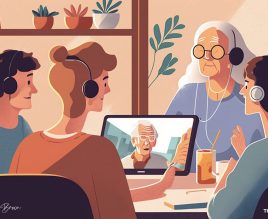Table of Contents
ToggleOnline spaces provide the older generation with a unique opportunity to pursue entrepreneurship, thanks to the flexibility and potential for innovation it offers. Additionally, these digital platforms are becoming increasingly crucial, given the ongoing global health crisis and the need for safer, contactless interactions.
In a world constantly driven by technology, it’s easy to overlook a significant segment of the population. The silver economy, encompassing older adults, is a burgeoning market that remains surprisingly untapped in the realm of digital entrepreneurship.
This piece will explore the growing intersection between the silver economy and digital technology, focusing on the rise of digital entrepreneurship for seniors, the role of online marketplaces, and the need for contactless payment options tailored for this demographic. We aim to help businesses, policymakers, and tech innovators better understand this demographic and cultivate a more inclusive digital landscape.
The Rise of Digital Entrepreneurship for Seniors
As we age, our needs and interests evolve. However, the entrepreneurial spirit doesn’t diminish with age. In fact, the emergence of digital platforms has created a fertile ground for senior entrepreneurs to flourish. This section will delve into the inspiring rise of digital entrepreneurship among older adults, the unique challenges they face, and the innovative solutions they bring to the table.

Harnessing the power of technology, senior entrepreneurs are redefining the rules and proving that age is no barrier to success in the digital landscape. The rise of digital entrepreneurship for seniors is not just a trend, it’s a revolution.
Senior-friendly Online Business Ideas
The Internet offers endless opportunities for entrepreneurship, especially for seniors looking to share their wealth of knowledge, skills, and experience. Identifying a niche that appeals to them and meets the market’s needs is key to building a successful online business.
This section will explore a few senior-friendly online business ideas that have the potential to thrive in the digital landscape. From hobby-based businesses to consulting services, these ideas capitalize on the unique strengths and interests of older adults.
1. Crafting and Hobby-based Businesses
Crafting and hobby-based businesses present an excellent opportunity for seniors to monetize their passions and skills. Whether it’s knitting, woodworking, painting, or gardening, the Internet allows individuals to create a virtual storefront for handmade products. Platforms like Etsy, eBay, or Amazon Handmade provide easy access to a global market, making it easier to reach potential customers.
Additionally, these platforms handle the logistics of online selling, like payment processing and shipping options, allowing seniors to focus on their craft. Not only do these businesses offer financial benefits, but they also provide a sense of purpose and community engagement, all while encouraging seniors to pursue their passions.
2. Consulting and Coaching Services
Many seniors possess a wealth of knowledge and experience in specific fields, making them ideal candidates for consulting or coaching services. This could be in areas like business management, financial planning, life coaching, or even wellness and fitness. By leveraging digital platforms like LinkedIn, seniors can connect with a wider audience in need of their expertise.
Additionally, tools like Zoom or Skype enable virtual one-on-one sessions or group consultations. Offering consulting services not only monetizes years of hard-earned expertise but also helps others in the process, creating a rewarding experience for senior entrepreneurs.
3. Online Courses and Workshops
In the age of lifelong learning, online courses and workshops are an effective way for seniors to share their knowledge. Platforms like Coursera, Udemy, or Skillshare provide the infrastructure to create and sell courses on a wide range of topics, from art and cooking to business and technology.
These courses can be prerecorded, allowing flexible work hours, and can reach a global audience. By creating online courses, seniors contribute to a culture of continuous learning and reap financial benefits while doing so.
Tools and Platforms for Launching Online Businesses
Once a business idea is in place, the next step for senior entrepreneurs is finding the right tools and platforms to bring it to life. Digital tools have made it easier than ever to launch and manage online businesses, even for those without extensive tech knowledge.
This section explores some essential tools that can aid seniors in launching their online ventures. From website builders to social media marketing, these resources aim to simplify the process of starting an online business.

1. Website Builders and eCommerce Platforms
Website builders like Wix, Weebly, or Shopify are user-friendly tools that allow anyone to create a professional-looking website without needing to code. These platforms often come with eCommerce capabilities, making it easier for seniors to set up an online store and manage their inventory.
They also offer design templates, so users can customize their site to reflect their brand. With the availability of such platforms, building a website and launching an online business have become more accessible than ever.
2. Social Media and Online Marketing
Social media platforms are powerful tools for promoting an online business and reaching a wider audience. Facebook, Instagram, LinkedIn, and Twitter each offer unique ways to connect with customers. They provide opportunities for interaction, feedback, and customer service.
Additionally, these platforms offer advertising options that can target specific demographics, enhancing the efficiency of marketing efforts. For senior entrepreneurs, utilizing social media and online marketing can be a game-changer, helping their businesses gain visibility and growth.
3. Payment Processing and Invoicing
Accepting payments and managing invoices is a crucial part of running an online business. Fortunately, there are many user-friendly tools available that can streamline this process. Services like PayPal, Square, or Stripe offer secure options for online payment processing. They allow businesses to accept credit card payments, digital wallet payments, and even international transactions.
Additionally, tools like QuickBooks or FreshBooks provide invoicing solutions, helping businesses to track sales, taxes, and expenses. By integrating these tools, senior entrepreneurs can ensure a smooth and professional financial transaction process for their customers.
Navigating Online Marketplaces for Older Adults
Online marketplaces have revolutionized the way we shop, providing convenience and a wide range of products at our fingertips. For older adults, these platforms offer an opportunity to shop from the comfort of home. But finding the right marketplace and ensuring a secure shopping experience can be challenging. This section aims to help seniors navigate online marketplaces effectively and safely.
Top online marketplaces for seniors
Finding the right online marketplace can make all the difference in the shopping experience. Different platforms cater to various needs and interests. Here, we will focus on some of the top online marketplaces particularly beneficial for older adults, considering factors like product range, ease of use, and customer support.
1. Amazon, eBay, and Etsy
Amazon, eBay, and Etsy are among the most popular online marketplaces worldwide. Their extensive product range, user-friendly interfaces, and reliable customer service make them ideal for older adults. While Amazon and eBay offer virtually everything, from electronics to groceries, Etsy specializes in unique handmade items and vintage goods.
2. Niche Marketplaces for Specific Interests
For specific interests, niche marketplaces like Bonanza (for collectibles) or Poshmark (for fashion) can be great options. These platforms cater to specific customer needs and often offer a more personalized shopping experience. It’s worth exploring these niche marketplaces to find items that align with individual hobbies and passions.
Tips for Safe and Secure Online Shopping
As convenient as online shopping is, it’s crucial to be mindful of safety and security. The digital world has its fair share of risks, including fraudulent activity and data breaches. This section will provide older adults with practical tips to maintain security while enjoying the benefits of online shopping.
1. Reading Reviews and Comparing Prices
Before purchasing, it’s wise to read reviews and compare prices across different sellers or platforms. This not only ensures the best deal but also helps ascertain product quality and seller credibility. Many platforms offer customer reviews and ratings, which can be invaluable in making informed purchasing decisions.
2. Protecting Personal Information
It’s essential to be vigilant about personal data protection when shopping online. Make sure to use secure payment methods, avoid sharing sensitive information over unsecured networks, and regularly update passwords. Using websites with ‘https’ in the URL and looking for trust seals can also add a layer of protection against potential online fraud.
Embracing Contactless Payment Options
In a world swiftly moving towards digitization, contactless payment options have emerged as a cornerstone of safe and convenient transactions. For older adults, these payment methods can offer added ease, security, and autonomy in managing their finances. This section delves into the growing adoption of contactless payments among seniors, the benefits they provide, and popular options suitable for this demographic.
The Growth of Contactless Payments for Older Adults
The past few years have witnessed a significant rise in the use of contactless payments, particularly among older adults. Initially, this surge was largely driven by the need for safer transaction methods amid the global health crisis.
However, as more seniors have experienced the convenience and security of contactless payments, they have continued to use and embrace these methods, signaling a significant shift in their financial behavior. In this part, we’ll examine how these payment options cater to seniors’ needs, providing convenience and enhanced security, ultimately empowering them in the digital economy.
1. Convenience and Ease of Use
One of the primary reasons seniors are adopting contactless payments is their convenience and ease of use. With just a tap of a card or a few clicks on a smartphone, transactions can be completed swiftly and efficiently. There’s no need to carry cash or checks, and payments can be made anytime, anywhere.
Some digital platforms even allow for automatic payments for regular expenses, eliminating the need to remember due dates. For seniors who may struggle with mobility or memory issues, these features make contactless payments an incredibly useful tool in their daily lives.
2. Improved Security and Fraud Protection
Contactless payments also offer enhanced security features that make them an attractive choice for older adults. These methods often employ advanced technologies like encryption and tokenization to secure transactions, reducing the risk of fraud. Furthermore, digital payments allow for real-time tracking and alerts, enabling seniors to monitor their spending and promptly report any suspicious activity. This level of security and control provides peace of mind and contributes to the growing popularity of contactless payments among seniors.
Popular Contactless Payment Methods for Seniors
The realm of contactless payments is diverse, offering numerous methods that cater to varying needs and comfort levels with technology. From mobile wallets to contactless cards, there are plenty of options available. However, not all might be suitable or user-friendly for older adults. This section will focus on the most popular contactless payment methods for seniors, considering their simplicity, accessibility, and security features.
1. Mobile Wallets and Digital Payment Apps
Mobile wallets and digital payment apps like Apple Pay, Google Pay, and PayPal have made it incredibly simple for seniors to handle transactions. With these services, users can store card information securely on their devices and make payments with just a few taps. These apps also allow for peer-to-peer transfers, making it easy to send money to family or friends. With intuitive interfaces and step-by-step guides, these apps are becoming increasingly accessible to seniors.
2. Contactless Credit and Debit Cards
Contactless credit and debit cards are another popular choice among seniors. These cards use Near Field Communication (NFC) technology to allow for quick and easy payments — just tap the card at the point-of-sale terminal, and the transaction is complete. Many banks and financial institutions offer these cards, often coupled with fraud protection measures, making them a safe and straightforward option for older adults.
The Future of the Silver Economy in the Digital Age
As digital technology continues to evolve, it’s shaping new possibilities for the silver economy. While older adults are increasingly engaged in digital entrepreneurship, online marketplaces, and contactless payments, there’s more on the horizon.

Advancements in technology promise to further enhance financial inclusion and the development of senior-focused products and services, leading to an even more vibrant and inclusive digital age for seniors. This final section will delve into the role of technology in shaping the future of the silver economy and explore some of the latest innovations tailored for older adults.
The Role of Technology in Improving Financial Inclusion
Digital technology is playing a critical role in improving financial inclusion for seniors. It not only simplifies transactions but also provides accessibility to a wide array of financial services right from the comfort of home. From online banking and investments to insurance and financial planning, seniors can manage all aspects of their finances digitally. Moreover, fintech innovations are continually making these services more user-friendly and customized for older adults, thereby bridging the digital divide and promoting an inclusive digital financial ecosystem for all ages.
Innovations in Senior-Focused Products and Services
In response to the growing digital engagement of seniors, companies are developing more products and services specifically tailored to their needs and preferences. These include senior-friendly apps and devices, online platforms for healthcare and wellness, virtual social engagement tools, and AI-powered assistants for daily tasks.
Such innovations are transforming the digital landscape for the silver economy, making it more accessible and enriching. As technology advances and the digital literacy of older adults improves, we can expect a future where the silver economy thrives even more in the digital age.
Conclusion
In the face of rapid digital evolution, it’s crucial that we don’t leave our older adults behind. The silver economy holds tremendous potential in the digital landscape, both as consumers and entrepreneurs. Embracing the digital world isn’t just about adapting to the latest trends; it’s about creating an inclusive space where everyone, regardless of age, can thrive.
It’s about providing tools and opportunities that enable seniors to participate actively in the digital economy. As the world becomes increasingly digital, there’s a growing need to make technology more accessible and user-friendly for older adults.
As we look to the future, we must continue to innovate and develop solutions tailored to the needs of the aging population. By doing so, we can create a digital environment where everyone can participate and benefit. Ultimately, empowering older adults in the digital economy is about recognizing and capitalizing on their potential, providing them with the opportunities they deserve.
FAQ
What is the Silver Economy?
The Silver Economy refers to the economic opportunities that arise from the spending power of older adults. It includes goods and services that meet the needs of people aged 50 and above, ranging from healthcare to technology and leisure.
How can older adults protect themselves from online scams and fraud?
Older adults can protect themselves by using secure websites for transactions, not sharing sensitive information, regularly updating passwords, and being cautious of unsolicited communications. Reading reviews and ratings before purchases can also help identify credible sellers.
Are contactless payments safe for older adults?
Yes, contactless payments are generally safe. They use encryption for transactions, offering security. Features like biometric authentication and transaction alerts also provide fraud protection. However, it’s important to stay vigilant and follow best practices for online safety.
References
- https://www.ilo.org/
- https://hbr.org/
- https://entrepreneurhandbook.co.uk/

















